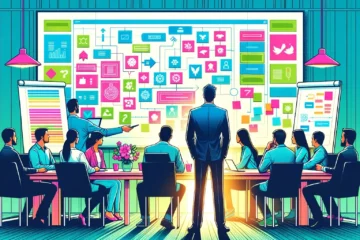In today’s rapidly evolving digital landscape, Marketplaces have become the cornerstone of online commerce, enabling individuals and businesses to connect, buy, and sell products and services seamlessly. According to Forrester, 60% of world e-commerce sales come from marketplace platforms. So what do you need to know about Custom Marketplaces Development in 2023 to stay caught up?
Artelogic is a Software Development House with experience and expertise in Custom Marketplace Development and blockchain technology. Contact our experts if you need more details about Marketplace development.
This blog delves into the fascinating world of marketplace development, exploring its various types, prevalent business models, the growing trend of private marketplaces, and the emergence of non-fungible tokens (NFTs) as a game-changer in the marketplace landscape.
How does the Marketplace as a Service work?
The concept of Marketplace as a Service (MaaS) has gained significant traction in recent years. MaaS platforms provide businesses with the infrastructure and tools to create and manage online marketplaces. These platforms offer a range of features, including product listings, secure payment gateways, user authentication, and dispute resolution mechanisms. By utilizing MaaS, companies can focus on building their brand and growing their customer base without the complexities of building a marketplace from scratch.
Marketplace History: Short Overview & Players
The advent of app stores, such as Apple’s App Store and Google Play, and e-commerce pioneers like eBay were the root of modern marketplaces. These centralized platforms allowed developers to distribute their applications to a massive user base, revolutionizing the software industry. The success of app stores paved the way for other types of marketplaces to emerge, including e-commerce platforms like Amazon and eBay.
In 2023, a “marketplace” no longer exclusively refers to giants like Amazon, eBay, or AliExpress. “We have seen a significant rise in the popularity of apps, services, and marketplaces that connect various stakeholders in niche markets. Companies like Etsy, Clutch, Shutterstock, LinkedIn, Expedia, Uber, and Apple Music have successfully capitalized on this trend by launching platforms that facilitate connections between local vendors and their potential customers.” – said Oleksandr Trofimov, Chief Technology Officer at Artelogic.
These platforms cater to different sectors, including B2C (business-to-consumer), B2B (business-to-business), and C2C (consumer-to-consumer) interactions.
Interestingly, in 2022, consumers spent $3.25 trillion on the top 100 online marketplaces, highlighting these platforms’ significant role in global retail e-commerce sales, which amounted to $5.7 trillion.
Types of Marketplaces
Marketplaces come in various forms, catering to different niches and audiences. Some common types of marketplaces include:
- NFT Marketplaces: NFTs have taken the digital world by storm, allowing individuals to buy and sell unique digital assets like artwork, collectibles, and virtual real estate. NFT marketplaces, such as OpenSea and Rarible, facilitate these transactions, leveraging blockchain technology for provenance and authenticity.
- App Marketplaces: These platforms, like Apple’s App Store and Google Play, connect app developers with millions of potential users, enabling them to distribute and monetize their applications.
- Service Marketplaces: Platforms like Upwork and Fiverr connect freelancers with clients seeking specific services, such as graphic design, programming, or content writing.
- B2C and B2B Marketplaces: Amazon and Alibaba exemplify B2C marketplaces, offering consumers a wide range of products. On the other hand, B2B marketplaces, such as Thomasnet and Alibaba Business, focus on facilitating business transactions.
- C2C Marketplaces: Websites like Shutterstock and Etsy provide a platform for individuals to buy and sell goods directly to other consumers, promoting a peer-to-peer economy.
Popular Marketplace Business Models in 2023 (+ Their Risks)
Marketplaces employ various business models to generate revenue. “However, along with the immense opportunities, there are inherent risks associated with these popular marketplace models.” – says Ihor Prudyvus, Engineering Director at Artelogic.
Some common approaches include:
- Commission-Based Model: In the commission-based marketplace, platforms charge for each transaction. These fees can be a fixed percentage, a flat rate, or a variable commission, depending on the transaction value. For example, Aliexpress operates using a commission-based model, where vendors pay a commission ranging from 5% to 10% based on the category of the items they sell.
Risk: The challenge lies in determining the optimal fee amount that ensures a steady income without discouraging customers. It is crucial to analyze the fees of competing marketplaces and develop a competitive pricing strategy.
- Subscription-Based Model: The subscription-based marketplace charges regular fees to sellers, buyers, or both for accessing and using marketplace services. The model requires providing enough value to justify recurring payments, which can be daily, monthly, or annually. For example, Shutterstock offers three membership options for downloading licensed photo and video content. Prices vary based on the monthly download limit, starting from $29.
Risk: The model faces the risk of losing customer loyalty. One approach to mitigate this is offering different subscription tiers with discounts or fee-sharing options. For instance, Apple Music gives Standard, Student, and Family memberships, while Shutterstock provides an annual payment discount.
- Listing Fee: The listing fee revenue model entails vendors paying a marketplace for each listing they create on the platform. In other words, they need to make a payment every time they post a new item. Who uses this model? Craigslist! This ads marketplace allows users to publish ads for free unless they fall under specific categories. For example, job postings cost between $10 and $75, while apartment rental ads cost $5.
Risk: As a newly established platform, your marketplace may need help to gain enough trust to justify charging for listings. Therefore, waiting until you have generated some initial income might be necessary. This model rarely functions effectively, so we recommend combining it with other monetization approaches.
- Lead-Fee Model: The Pay-for-Lead marketplace business model operates on payments from vendors. Vendors can use the platform for free but only pay when they successfully find buyers. Unlike the Commission-Based Model, there are typically no transactions on a lead fee marketplace. Instead, vendors gain access to customer contacts. An example of a company utilizing this model is HomeAdvisor, a home improvement marketplace. They charge contractors $50 for each lead they acquire through the platform.
Risk: The primary risk is marketplace leakage when dealing with lead-based sales. It can illustrate the situation where the marketplace successfully connects a buyer and a vendor. However, while the initial transaction brings in some income, the two parties may continue their partnership outside of the platform in the future. To prevent such risk, marketplace managers must find a reasonable price that does not exceed the average market rate.
Custom Marketplace Development: Why Do Businesses Develop Private Marketplaces?
Private or niche marketplaces are platforms that cater to the specific needs of industry players. Businesses usually launch these marketplaces to expand their services and allow other suppliers to showcase their services, such as apps and plugins, on the dedicated platform.
“This controlled environment provides enhanced control over ad placement, often offering premium positioning opportunities,” – adds Oleksandr Trofimov, Chief Technology Officer at Artelogic.
Interesting fact! Private Marketplace Deals (PMPs) had a meteoric rise in 2022, accounting for 39.6% of all programmatic transactions, according to Statista.
Private marketplaces have gained popularity among businesses for several reasons:
- Enhanced Control: By Custom Marketplace Development, businesses can maintain complete control over the user experience, branding, and data privacy, ensuring seamless integration with their existing operations.
- Customization: Private marketplaces can be tailored to the specific needs of a business, offering unique features, integrations, and workflows that align with their industry and target audience.
- Monetization Opportunities: Businesses can leverage their marketplace to generate additional revenue streams, such as charging suppliers for access, offering premium services, or facilitating value-added transactions.
- Data Ownership: Private marketplaces allow businesses to retain ownership of the valuable data generated by user interactions, enabling them to gain insights and make data-driven decisions.
What about the Custom Marketplace Development example?
The Artelogic team developed a Business App Store for Bitergo, a German-based company that manages business apps to optimize warehouse management, scalable from startups to 4PL companies.
Bitergo provides diverse business apps for efficient warehouse management, suitable for small startups and large 4PL companies. Their collection includes web and Android apps, enabling companies to set up a digital warehouse quickly with Warehouse Star. Moreover, these apps stand out for their seamless integration with other systems.
The Trend in Custom Marketplace Development: NFTs and How They Work
A non-fungible token (NFT) is a distinct form of digital asset with individual ownership and control, making it inherently unique. Unlike cryptocurrencies, non-fungible tokens cannot be replicated, ensuring that only a single instance of each token exists at any moment.
The NFT market size in 2023 is already worth more than $41 billion, while OpenSea, the largest NFT marketplace, has increased its trading volume by $3 million, 800% higher than the previous year.

“NFTs, digital assets mirroring real-world items like art and music, are generated using blockchain technology. They are subsequently exchangeable between parties through an encrypted smart contract system that utilizes “NFTs” or “non-fungible tokens.” These tokens symbolize distinct assets, akin to shares or securities, providing value beyond mere digital replicas of physical items such as coins or dollar bills.” – explained Ihor Prudyvus, Engineering Director at Artelogic.
NFT Industry Trends in 2023
Artificial Intelligence
- Integrating artificial intelligence into non-fungible tokens introduces a new dimension of uniqueness, as these tokens can generate dynamic images based on algorithms. The market may undergo significant changes with AI-powered techniques that produce unprecedented works of art. Furthermore, algorithmic generative digital collectibles can adapt and update in response to future data changes or events.
NFTs in Gaming
- According to play-to-earn game industry entrepreneurs, the convergence of gaming and non-fungible tokens is near to a remarkable surge. Enthusiasts and influencers see this fusion as a prominent trend shaping the realm of digital collectibles in 2023. For example, NFTs represent virtual land within gaming environments, particularly in the context of the metaverse. Players can purchase, own, and develop virtual properties that hold value within the game and the broader metaverse ecosystem.
NFTs in Healthcare
- Digital collectibles offer secure storage for patient records, incentivize patient participation in research data collection, and provide healthcare professionals with quick and reliable access to medical data, eliminating the risks associated with traditional paper documentation. Furthermore, one more example, NFTs can represent virtual healthcare assets, such as virtual medical equipment, surgical simulations, or telemedicine platforms. These assets can be owned and traded, allowing healthcare organizations to create virtual training environments or offer virtual healthcare services.
NFTs in Fashion
- With the exponential growth of the fashion NFT market, major players in the industry are increasingly investing digitally through non-fungible tokens. Fashion NFT platforms like DIGITALAX are revolutionizing the fashion sector by leveraging these digital assets. The fashion industry can become the hottest trend in the NFT space in 2023. Several luxury NFT brands have established their virtual stores within the metaverse. One notable example is Gucci, which created the Gucci Vault store in The Sandbox, showcasing a collection of their most exceptional vintage Gucci apparel.
NFTs in Real Estate
- Non-fungible tokens are gaining traction in the real estate sector, offering secure transactions for buyers and sellers while eliminating the risks associated with physical paperwork. By enabling the transmission of legal documents digitally, this technology significantly reduces paperwork while ensuring complete accuracy. For example, NFTs can represent virtual real estate within virtual worlds or metaverse environments. Users can purchase and own virtual land or properties through NFTs, allowing them to build and customize their virtual spaces and monetize them through virtual commerce or events.
In conclusion, custom marketplace development trends are playing an increasingly pivotal role in the success of businesses globally. They offer a transformative way to engage consumers, streamline operations, and diversify revenue streams.
Furthermore, custom marketplace development allows businesses to cater to their unique needs and those of their customers. It provides the flexibility and scalability that pre-built solutions may lack, setting the groundwork for long-term business growth.
In an increasingly digital and interconnected world, staying abreast of these trends in custom marketplace development can give businesses a significant competitive edge. It will enable them to drive innovation, foster customer loyalty, increase profitability, and ensure their survival and success in the rapidly evolving global marketplace.


















